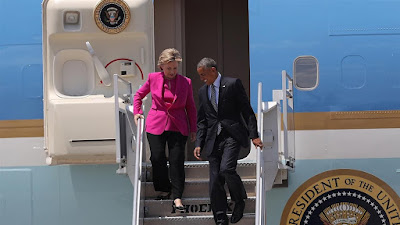President-elect Donald Trump avoided reporters as he left Trump Tower for the first time in days. (Photo: William Edwards/AFP)
The
protective pool is not just a megaphone, though the collected outlets
— representing newswires, television, radio, photographers and what is
still called “print,” even though it’s mostly digital — have vast
worldwide reach. The assignment also comes with a duty to question the
president and top aides. One of the things that make the United States
special is the news media’s ability to do this, on a regular basis,
while the president is discharging official functions. This is a
recognition of the commander in chief’s unique importance in world
affairs, and of the value of relying on an independent news media (with
all of its considerable faults) rather than a state-run propaganda
apparatus.
In
order to do all of this — the news, the history, the potential crisis
coverage, the questions — the press pool remains quite close to the
president. In practice, this means that there are typically at least two
press vans in the presidential motorcade. On domestic and international
trips, reporters pay for seats in the very back of Air Force One. When
the president is in town, the pool members report to the White House
every day, to be their colleagues’ eyes and ears. Reporters typically
get pulled into the Oval Office when the president meets with world
leaders or the Cabinet. The job takes reporters to the Burger King at
Joint Base Andrews for endless hours while President Obama golfs. (The
pool rarely glimpses him on those outings, but would be nearby in the
event of a crisis.) Poolers can expect long hours in vans outside luxury
homes when a president fundraises.
Sometimes, the job can be goofy fun, as was the case on my first pool with Obama, a St. Patrick’s Day outing in 2012.
But even then, poolers can feel a nervous sense of duty. It’s hard to
forget that the job took reporters to a Florida schoolroom on a sunny
mid-September morning 15 years ago for an education-themed event that
White House officials had privately described as news-less.
On
Tuesday night, President-elect Donald Trump ditched his press pool and
went out for a steak dinner. Reporters were mocked for making a big deal
of the incident, which did not feature Trump’s traveling far from his
Trump Tower headquarters in Manhattan. But it’s unprecedented in modern
history for a president-elect not to have a protective pool — though it
was also unprecedented for neither nominee to have one coming out of the
party conventions. Hillary Clinton paid a price for not having a
protective pool when she collapsed and was whisked away on Sept. 11: The
sudden, unexplained disappearance of the Democratic nominee for
president, like the unspecified technical glitches on Cheney’s plane,
generated quite a bit of feverish speculation. (Obama has ditched the
pool on a few occasions, prompting strenuous complaints from the White House Correspondents’ Association, which represents the interests of the press corps.)
Kellyanne
Conway, campaign manager for President-elect Donald Trump, talks with
reporters as she arrives at Trump Tower on Monday. (Photo: Evan
Vucci/AP)
Trump
spokeswoman Hope Hicks has assured the news media that the
president-elect’s team is working to arrange a protective pool, after
which the news media will get “all of the access that they have ever had
under any president.”
That
doesn’t mean that reporters would have been in a position on Tuesday to
say whether the president-elect likes his steak medium-rare or shout
questions that would have annoyed other diners. When the commander in
chief goes out for dinner, the pool typically waits (“holds,” in our
jargon) in a nearby restaurant or in vans. It’s often accompanied by a
Secret Service agent whose job isn’t to protect us but to make sure that
no stowaways join the press and slip into the security “bubble”
protecting the president.
That
“bubble” is a big reason for the pool. Those golf outings are tedious,
but in a national emergency, Joint Base Andrews might go on lockdown,
making it impossible for reporters to get anywhere near the president
for an extended stretch of time. When a president travels overseas to
multiple destinations, it would be enormously difficult to get reporters
in place at every stop through security on the ground.
And
the media is mindful of that security. To be part of the pool on that
long-ago Cheney trip, reporters had to agree to tell just one editor
that they were going to Pakistan and Afghanistan. But the seriousness of
the potential threat really came home when a veteran Secret Service
agent, upon hearing inaccurate rumors that someone had reported the vice
president’s plans, asked me on approach to Islamabad: “You’re not going
to get us all killed, are you?”














0 comments:
Post a Comment